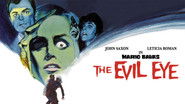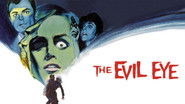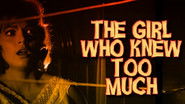grahamcarter-1
'Giallo' initially found its roots in the German 'Krimi.' These were adaptations of British writer Edgar Wallace mystery and crime stories, made specifically for the German market between 1959 and 1972. 'Giallo' were more baroque in style and notable for extended murder sequences, stylish camera work, and Grand Guignol style drama. Full of madness, alienation and paranoia; atmosphere is everything and character development, acting, and strong pacing are immaterial. Unlike the American horror / stalker / slasher / final-girl films, the killer is rarely male or suffers from gender confusion that places him in the feminine position; Argento's The Bird With The Crystal Plumage (1970) is an example, as is Fulci's A Lizard In A Woman's Skin (1971). Almost as a convention, 'Giallo' titles frequently feature animals or numbers, such as Fulci's Don't Torture a Duckling (1972), or Umberto Lenzi's Seven Blood Stained Orchids (1972). Mario Bava's "The Girl Who Knew Too Much" (1963) is considered the first 'Giallo' film. A cinematographer who received his first chance to direct finishing Riccardo Freda's 1956 I Vampiri (which is considered the first Italian horror film), Bava then handled cinematography and special effects on Hercules (1957) kick starting the sword and sandal genre. He shot The Day The Sky Exploded (1958), which is the first Italian sci-fi film, with a large German 'Krimi' cast. He then had a chance to shoot and finish directing another Freda film, Caltiki – The Immortal Monster (1959), a genre favourite. It is remarkable to watch Planet Of The Vampires (1965) and then take a moment to think about whether Alien (1979), could exist without it (answer? It couldn't). Bay Of Blood / Twitch Of The Death Nerve (1971) was hugely influential in regards the American 'slasher'/'body count' genre. The Girl Who Knew Too Much establishes what will become one of the critical conventions of 'Giallo,' that of an outsider or foreigner who witnesses a murder and investigates the crime. Trouble comes when warnings not to get involved are ignored. 'The Girl…' is more restrained than any of Bava's later 'Giallo,' in which he would develop a baroque and garish use of colour. Filmed in black and white that connects it to film-noir (the literary-pulp origins of 'Giallo'), and Hitchcock's influential Psycho (1960, and the title refers to Hitchcock's 1934 and 1956 The Man Who Knew Too Much), Bava mixed in the conventions of the thriller, film noir and horror creating 'Giallo.'Check it out!
Bezenby
The first Giallo, or so I've heard. Before the Giallo was the German Krimi films, also murder mysteries with a fair bit of comedy, I understand. Of course, the Giallo were based on the yellow murder mystery books on sale in Italy at the time, and before that was Agatha Christie, and so on and so forth. However, the Giallo Mario gives us is full of future clichés, but almost right away Bava starts messing with the genre! Oh, you, Bava.Nora arrives in Rome from New York and immediately starts having a really bad day. The guy hitting her on the plane was smuggling drugs, the Aunt she was visiting dies of a heart attack that night, and she gets mugged on the Spanish Steps. Not only that, but while reeling from a sore head after getting mugged, she thinks she sees a woman getting stabbed in the back by a fella! The only good thing that happened was that she met Marcello, a hunky young doctor played by John Saxon. Saxon's all out to help Nora get to the bottom of the mystery (there's no body and nobody believes her) but I think Marcello is just trying to get into her pants.Nora moves into an apartment next to the Spanish Steps and Bava clues us in right away that this is a bad move by sliding the camera towards a mysterious locked door before Nora even notices it, then a framed picture of the man Nora thought she spotted during the murder. Uh oh! Bava does this a lot during this film, and to be honest that's why I'm such a fan of his work. Every part of this film is beautifully constructed, from the scene were Nora is drawn to an apartment where the bare lightbulbs sway in the wind of an open window while an unseen voice talks and taunts Nora, to the use of shadows even in the most routine of scenes (like the printers, were a simple 'tracing a character' scene becomes a lovely display of shadows on fabric). The only thing that doesn't work out is some of the comedy, although it is funny that Saxon ends up with various injuries as the film carries on.My favourite scene is when Nora visits someone else investigating the murders, and from outside the apartment hears the hammering of a typewriter. After trying to get the person to open the door, she finds it open, and the camera pans across the room...to a disused typewriter...then to a tape recorder playing the sound of someone typing. I love it when Bava does this and he takes it to extremes in later films.This early Giallo was not successful, and it would take until the international success of Dario Argento's The Bird With The Crystal Plumage to launch the genre into overdrive. However, it does give me the chance to use the phrase Chiaroscuro and sound well wanky, for Bava use of the contrast between light and dark hints towards theory I have that these guy involved in Italian cinema aren't that far removed from the artists that populated Rome back in the days of Caravaggio.
jadavix
"The Girl Who Knew Too Much" is a tedious early example of the giallo formula. Historically it has little else going for it.I guess we can call it a giallo because of the familiar trope of the main character witnessing a murder and then becoming the next likely victim.I found the plot really hard to follow and impossible to interest myself in. Mario Bava, the Italian "Master of Suspense", isn't really the master of anything. I've seen almost all of his movies now and they all suck, just like this one. Thinly plotted boring garbage that you couldn't follow even if you wanted to.I said at the beginning of this review that the movie is historically significant because it is one of the first gialli. By that same token, Bava is historically significant for having made it, and a few of the others. His significance ends there.
runamokprods
Bava pays explicit homage to Hitchcock in this fun, mostly light hearted black and white mystery. An American girl vacationing in Rome witnesses what might be a murder (or is it her overactive imagination, spurred on by her love of cheap mystery novels?). And before you know it, she's the possible target of a serial killer. The black and white photography is beautiful, but Bava tones his style down just a bit, and it works; the photography compliments the story, without swamping it,. There are weak spots, like an annoying voice over that insists on explaining what the images are making very clear by themselves, and performances that are uneven (especially in supporting roles). But, the bottom line is, if it wasn't in Italian, one could even believe this was a Hitchcock film, which is a pretty high compliment...






